Wednesday, November 30, 2005
London - last day in Europe
Arrived back in Melbourne on Wednesday November 30th. Temperature in the high 20s, then hit 34 degrees on the Thursday. We are all knackered - can't even be bothered unpacking, but it's so nice to be home and to be back in our own beds and to see the babies (Neo and Xena) again.
Sunday, November 27, 2005
London
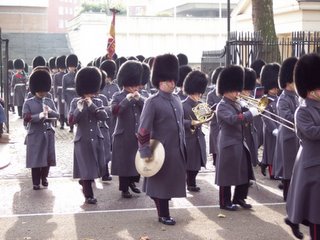
Well after losing most of yesterday we were determined to do as much as possible today- so up early and bought tickets for the hop-on hop-off bus here. Did stacks of stuff - saw the changing of the guards, sqirrels in Hyde Park,
 went on the London Eye, walked around Westminster Abbey and the Houses of Parliament and visited the Tower of London.
went on the London Eye, walked around Westminster Abbey and the Houses of Parliament and visited the Tower of London. 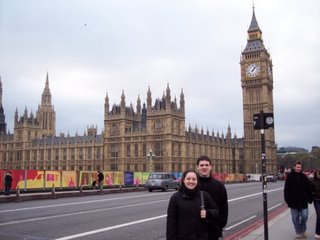
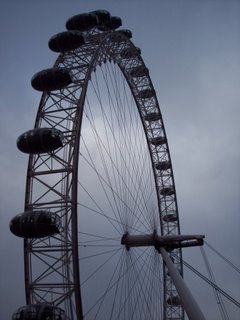 Walked until our feet were killing us, had hot chocolates at Starbucks, had a great day. I was particularly intrigued by the codpiece in Henry VIII's armour - either he was damned well-endowed or this was meant to scare enemies off!! hehehe
Walked until our feet were killing us, had hot chocolates at Starbucks, had a great day. I was particularly intrigued by the codpiece in Henry VIII's armour - either he was damned well-endowed or this was meant to scare enemies off!! hehehe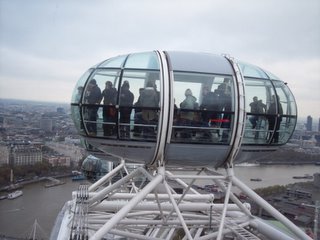
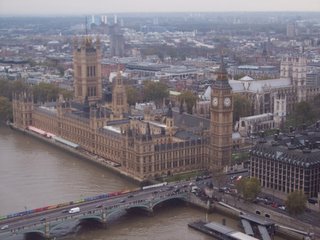
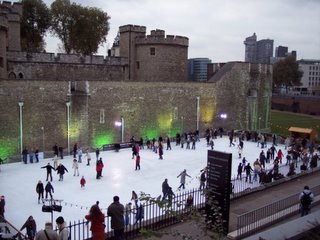
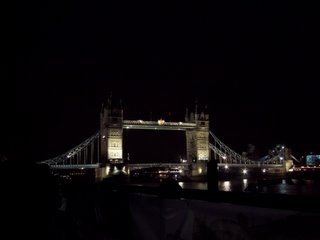
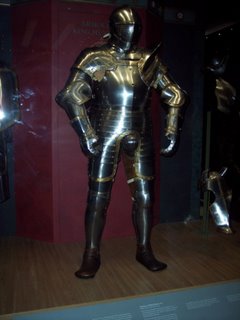
Saturday, November 26, 2005
trying to get to London
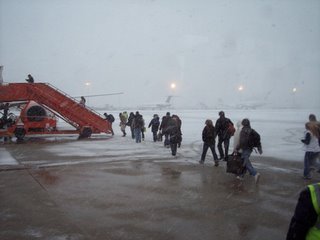 the snow! Anyway we were finally loaded onto the bus to be taken onto the plane, and made a dash through the snow to get on board. It was fun standing there brushing snow off our coats - dorky for others I know, but we Aussies don't see much in the way of snow! Anyway it kept snowing, and we sat there in the plane, with the steps still there and the door open, as the snow got heavier and heavier. The airport workers were having a ball, throwing snowballs at each other and generally horsing around, leaving luggage out in the snow to be piled 10 cm or so deep with snow!
the snow! Anyway we were finally loaded onto the bus to be taken onto the plane, and made a dash through the snow to get on board. It was fun standing there brushing snow off our coats - dorky for others I know, but we Aussies don't see much in the way of snow! Anyway it kept snowing, and we sat there in the plane, with the steps still there and the door open, as the snow got heavier and heavier. The airport workers were having a ball, throwing snowballs at each other and generally horsing around, leaving luggage out in the snow to be piled 10 cm or so deep with snow!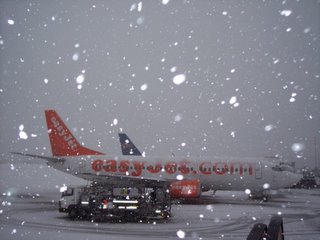
Basically they closed down all but one runway, and gave Air France planes priority, and our flight sat on the tarmac for 5 hours waiting to be de-iced and let go. Sigh. It was infuriating at the time, but it's one of those things that happen when you travel! Anyway, we finally took off and headed for England, passing over serious snowfalls on the way.
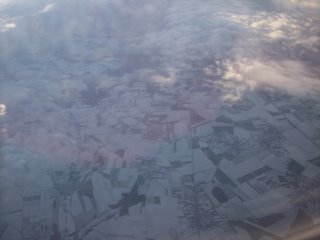
Took a bus from Luton to Baker street then a taxi to our hotel. Poky little room but it's only for a couple of nights. Daniel said that it was like showering in a Jeffries tube (Star Trek reference for the uninitiated!). Kids hanging out for fish and chips so we went to a local restaurant, where fish and chips, a few bits of calamari and sardines as entree, a glass of beer and two cokes set me back 55 pounds. Good grief I don't even want to convert that - if it were dollars it would be bac enough but this is daylight robbery!
C'est la vie. Tomorrow is another day, and at least it isn't snowing here!!!
Friday, November 25, 2005
Paris day 2
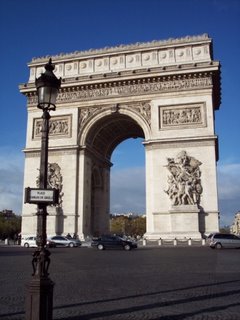 All tired and cold today, so decided to spend most of the day riding the buses.
All tired and cold today, so decided to spend most of the day riding the buses.First stop was on the Champs Elysees, after listening to the French reinvent their history in the bus commentary. We were told that the Arc de Triomphe was built to honour Napoleon, forgetting his exile and early death, and then we were told about the Allies marching through it to free Paris, but not the Nazis marching through it nor hanging a swastika from it. Anyway ....
Like spokes on a gigantic bicycle wheel, twelve streets feed into the motorway that circles the celebrated Arc de Triomphe. The most famous of these streets is the Champs Elysees, which extends all the way southeast to the Jardin des Tuileries on the north bank of the Seine.
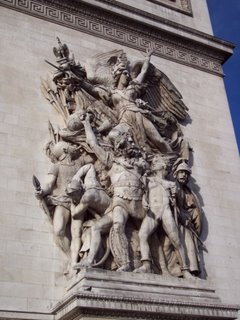
The designs on the outside are pretty amazing - this one - La Marsellaise - depicts heroically nude French youths fighting against bearded Germanic warriors in chain mail.
We climbed to the top - well we had to didn't we? The views really are spectacular, and it wasn't too cold... hahahahaha!


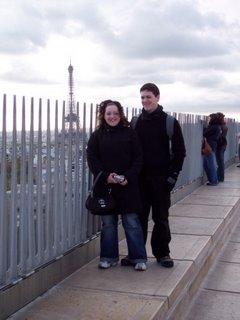
We ended the day at the Louvre. Spent some time wandering, just looking at things, before going to the Denon wing to look at the Mona Lisa and then up to the Dutch paintings in the Richelieu wing to see the Vermeers (and others). Would like to spend days there. Most intriguing painting we saw, which a young French museum guide explained to us in as much detail as she could manage and we could interpret, was called Gabrielle d'Estrees and one of her sisters in a bath. Gabrielle d'Estrees was the mistress of Henry IV. In her hand she hold a ring given to her by the king as a sign of their bond,
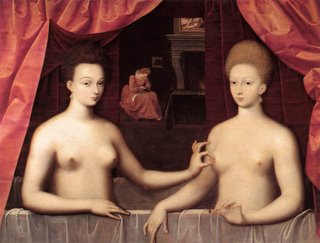 and indicates that she believes they will marry. Her sister is pinching her nipple to indicate she is pregnant with the king's child, and in the background the maid is sewing baby clothes. Their marriage was not to be - after giving Henry three children, Gabrielle died in childbirth aged 26.
and indicates that she believes they will marry. Her sister is pinching her nipple to indicate she is pregnant with the king's child, and in the background the maid is sewing baby clothes. Their marriage was not to be - after giving Henry three children, Gabrielle died in childbirth aged 26.Walked home. Fell into bed exhausted.
Have to be up early in the morning to negotiate subway to Charles de Gaulle to catch the EasyJet flight to Luton airport for our last stopover in London.
Thursday, November 24, 2005
To Paris
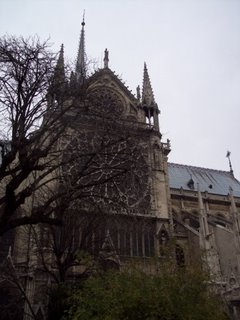
It was colder still in Paris, so although we went on a hop-on hop-off bus trip, there was no way I was going onto the top deck, which was a pity really. The bus was good value, and took us to where we wanted to go, although the commentary was ordinary. One of the first stops was Notre Dame, where we discussed flying buttresses and Charlemagne! Proceeded by a Gallo-Roman temple to Jupiter, a Christian basilica, and a Romanesque church, construction of Notre-Dame de Paris began in 1163 during the reign of Louis VII. It was completed in about 1250.
Jess had read in the tourist stuff about the Church of San Chappelle, which had a ceiling of stars, so we went to find it. It was part of the Palais de Justice complex.
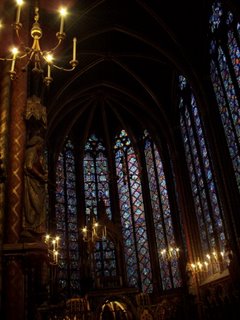 Walked into a church which was very small and seemed mainly closed off and scaffolded, and not nearly as picturesque as you would imagine - then found out we were in the under-chapel... walked up a flight of stairs and there it was in all its glory! Wonderful stained glass windows and fantastic ceiling, and an animated and very knowledgeable art history student talking about the frescoes. She really brought the whole history to life for us. The church was built in 1246 for Louis IX. Suposedly, above the alter, are thorns from the crown of thorns worn by Jesus, as well as a part of the true cross. We didn't see anything.
Walked into a church which was very small and seemed mainly closed off and scaffolded, and not nearly as picturesque as you would imagine - then found out we were in the under-chapel... walked up a flight of stairs and there it was in all its glory! Wonderful stained glass windows and fantastic ceiling, and an animated and very knowledgeable art history student talking about the frescoes. She really brought the whole history to life for us. The church was built in 1246 for Louis IX. Suposedly, above the alter, are thorns from the crown of thorns worn by Jesus, as well as a part of the true cross. We didn't see anything.Next, a visit to the Conciergerie. It was built on the Ile-de-la-Cité between 1284-1314, and now makes up much of the Palais de Justice complex. Its history as a place of imprisonment, torture, and death is is significant. It has some beautiful features, in particular the Salle des Gardes - the room of the guards with elegant vaulting - the colonnaded Salle des Gens d'Armes - 69m long and 27m wide now sometimes used for concerts - and the Cuisines with its four large fireplaces, each large enough to roast an entire ox.
Among its more famous prisoners was Marie Antoinette.
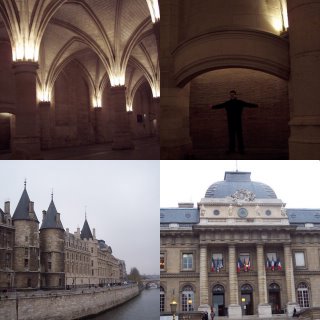 We walked around the Seine to the Eiffel Tower, which was, pardon the pun, quite insane. It was down to around 4 degrees, and started to rain as we got there. It was also, although only around 5pm, quite dark, and by the time we got our tickets for entry, dark and raining lightly- very close to snowing. Anyway we got tickets to go to the top, which scared the bejesus out of me, but where the kids go, I go - no wussing out!
We walked around the Seine to the Eiffel Tower, which was, pardon the pun, quite insane. It was down to around 4 degrees, and started to rain as we got there. It was also, although only around 5pm, quite dark, and by the time we got our tickets for entry, dark and raining lightly- very close to snowing. Anyway we got tickets to go to the top, which scared the bejesus out of me, but where the kids go, I go - no wussing out!It's a BIG tower.
Very high.
Like 300m high. Two platforms, two different lifts, one on an angle and one straight up to the top.
Ye gods what was I thinking?
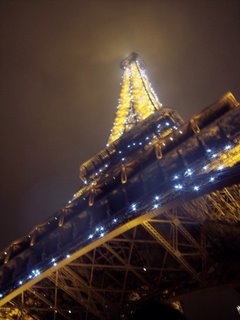
Insane thoughts obviously.. but I made it to the top - even climbed the stairs to the open area at the top, which was absolutely freezing!
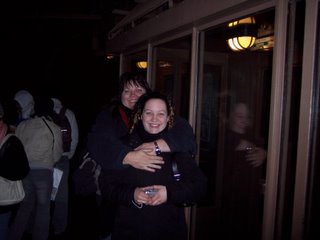
When we had frozen enough, we went down to the bar on the second level. Well it's not every day that you go to the top of the Eiffel Tower is it? Jess and I had a glass of champagne each, Daniel a coke.... and for that we paid 23Euros!!!! HAHAHAHA what a rip off! At least the restaurant was full so we didn't get stuck with that!
Wednesday, November 23, 2005
Rome part II - well actually Vatican City
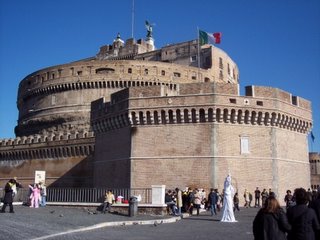
Originally, the mausoleum was a decorated cylinder, with a garden top and the golden quadriga of the emperor. In the following centuries, the mausoleum was converted into a military fortress, and included in the Aurelian Walls. The popes converted the structure into a castle, and in the 14th century Pope Nicholas III connected the castle to St. Peter's Basilica by a covered fortified corridor called the Passetto di Borgo. The fortress was the refuge of Pope Clement VII from the siege of Charles V's Landsknecht during the Sack of Rome (1527), in which Benvenuto Cellini describes strolling the ramparts and shooting enemy soldiers.
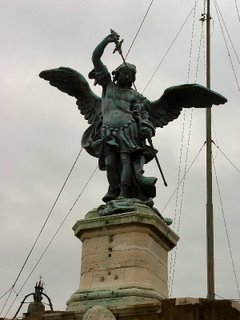 An 18th-century bronze angel sheathing a sword surmounts the tomb; legend holds that an angel had appeared on top of the mausoleum, sheathing his (her?) sword as a sign of the end of the plague of 590, thus lending the castle its present name.
An 18th-century bronze angel sheathing a sword surmounts the tomb; legend holds that an angel had appeared on top of the mausoleum, sheathing his (her?) sword as a sign of the end of the plague of 590, thus lending the castle its present name.
The most striking thing about the entrance to the Castle, both along the bridge and along the street between the Castle and St Peter's, was the number of people selling knock-off designer stuff. There were hundreds of them, all with their goods displayed on white sheets that they quickly gatehred up at the first sight of Caribiniere and bolted... not far though, just not right there! It's a farcical display, and one which we had seen a few times in Firenze as well, but this was a fine-ish day on a weekend and there were hundreds of them there.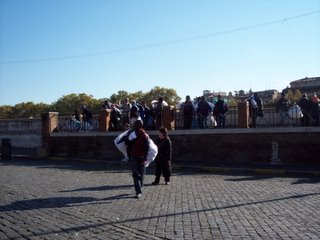
On to St Peter's Basilica. It's suggested that the current location is probably the site of the Circus of Nero, where Saint Peter was buried upon dying on an inverted cross. After Constantine I officially recognised Christianity, he started construction in 324 of a great basilica in this exact spot, which had previously been a cemetery for pagans as well as Christians. Tradition holds that St Peter's tomb is below the baldachino and altar; for this reason, many Popes, starting with the first ones, have been buried there. The current basilica was started in 1506 and completed in 1626, and was built over the Constantinian basilica. Among the architects to work on the Basilica were Bramante and of course Michelangelo, who designed the famous dome.
The double dome is brick, 42.3 m in interior diameter (almost as large as the Pantheon), rising to 120 m above the floor. It is not simply its vast scale (136.57 m from the floor of the church to the top of the added cross) that makes it extraordinary . Michelangelo's dome is not a hemisphere, but a paraboloid: it has a vertical thrust, which is made more emphatic by the bold ribbing that springs from the paired Corinthian columns, which appear to be part of the drum, but which stand away from it like buttresses, to absorb the outward thrust of the dome's weight. The grand arched openings(which can't be seen) enable access all around the base of the drum; they are dwarfed by the monumental scale of their surroundings. Above, the vaulted dome rises to the two-stage lantern, capped with a spire.
Above the main entrance is the inscription IN HONOREM PRINCIPIS APOST PAVLVS V BVRGHESIVS ROMANVS PONT MAX AN MDCXII PONT VII (In honor of the prince of apostles; Paul V, citizen of Rome, Supreme Pontiff, in the year 1612 and the seventh year of his pontificate).
The façade is 114.69 metres wide and 45.55 m high. On top are statues of Christ, John the Baptist, and eleven of the apostles; St. Peter's statue is inside. Two clocks are on either side of the top, the one on the left is electrically operated since 1931, with its oldest bell dating to 1288.
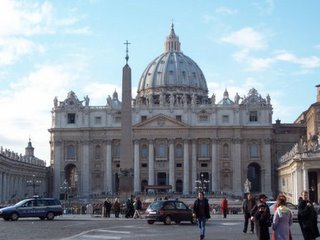 In front of the church is St. Peter's Square (Piazza San Pietro), built between 1656 and 1667. It is surrounded by an elliptical colonnade, designed by Bernini, consisting of 4 rows of 284 columns and 88 pilasters. The balustrade above the columns is decorated with 140 statues of Saints.
In front of the church is St. Peter's Square (Piazza San Pietro), built between 1656 and 1667. It is surrounded by an elliptical colonnade, designed by Bernini, consisting of 4 rows of 284 columns and 88 pilasters. The balustrade above the columns is decorated with 140 statues of Saints.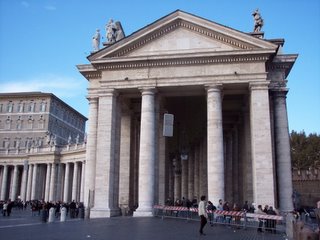
In the center of the colonnade, which was designed by Bernini, is a 25.5 m tall obelisk. The obelisk was moved to its present location in 1585 by order of Pope Sixtus V.
The obelisk dates back to the 13th century BC in Egypt, and was moved to Rome in the 1st century to stand in Nero's Circus. Including the cross on top and the base the obelisk reaches 40 m. On top of the obelisk there used to be a large bronze globe allegedly containing the ashes of Julius Caesar, this was removed as the obelisk was erected in St. Peter's Square. 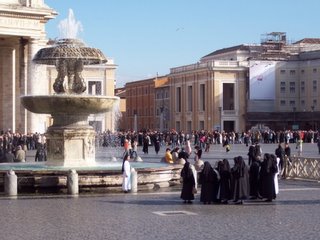
There are also two fountains in the square, the south one by Maderno and the northern one by Fontana.
A few things about the interior, as photos do not do it justice.
The Basilica is 187m long (212 including the portico). The perimeter of each of the four piers that support the dome is 71m. It can seat around 70,000 people, and a further 300,000 can fit into St Peter's square.
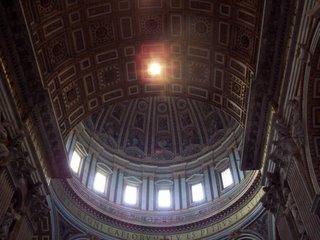
Along the base of the inside of the dome is written, in gold letters 2 m high, TV ES PETRVS ET SVPER HANC PETRAM AEDIFICABO ECCLESIAM MEAM. TIBI DABO CLAVES REGNI CAELORVM ("...you are Peter, and on this rock I will build my church. ... I will give you the keys of the kingdom of heaven....").
The bronze baldacchino, by Bernini, sits over the Papal alter; it's 29 m high.

Tuesday, November 22, 2005
All roads lead to Rome...
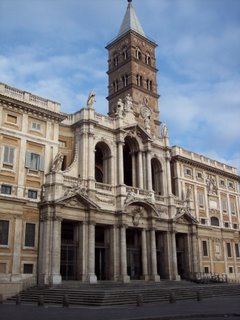 Arrived by train from Florence on the 22nd November. Cold but fortunately not raining. Found our hotel pretty easily, although we were somewhat put off by the group of young people milling around the entrance and the strong smell of dope in the entrance! The hotel was on the second floor, up a million steps again, but fortunately at this stage of the trip had a lift of sorts. We stayed right near Santa Maria Maggiore, which was built on the site of a Roman temple to the goddess Juno Lucina. She was a favourite of women, especially of pregnant women and those with small children. The Christian church was first founded in about 350 and hasa series of mosaics from that period, as well as the highest bell tower in Rome.
Arrived by train from Florence on the 22nd November. Cold but fortunately not raining. Found our hotel pretty easily, although we were somewhat put off by the group of young people milling around the entrance and the strong smell of dope in the entrance! The hotel was on the second floor, up a million steps again, but fortunately at this stage of the trip had a lift of sorts. We stayed right near Santa Maria Maggiore, which was built on the site of a Roman temple to the goddess Juno Lucina. She was a favourite of women, especially of pregnant women and those with small children. The Christian church was first founded in about 350 and hasa series of mosaics from that period, as well as the highest bell tower in Rome.Wandering through Rome in chilly winter weather is interesting... the kids found the city disorienting, but it's always fascinating as there's something around every corner or bend of cobblestoned roads.
On our rambles we came across the Piazza Minerva, in which this Bernini Elephant statue holds up an Egyptian obelisk from about 600BC. Ancient Rome had a temple to the Egyptian goddess Isis, and that temple had a row of obelisks which over the centuries have been spread out to sites all over the city.
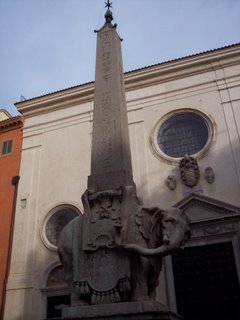 The monastery behind the church is the site where Galialeo was forced to reject his astronomical discoveries and swear, as the church commanded, that the Earth did not go around the sun.
The monastery behind the church is the site where Galialeo was forced to reject his astronomical discoveries and swear, as the church commanded, that the Earth did not go around the sun.Around the next corner is the Pantheon. It's hard to picture just how huge it is until you're standing staring up at the columns... The Pantheon was originally built as a temple to the seven deities of the seven planets in the Roman state religion. It was originally built in about 25BC during the third consulship of Marcus Vipsanius Agrips, and his name is inscribed on the portico of the building. The inscription reads M·AGRIPPA·L·F·COS·TERTIUM·FECIT, "Marcus Agrippa, son of Lucius, consul for the third time, built this." It was destroyed by fire in AD 80 and rebuilt by the Emporer Hadrian, around 125AD, and he added the inscription. It became a Christian Church in 608AD, and has been used continuously ever since. The dome is concrete and was made by piling up a huge mound of dirt, then pouring a concrete shell over the dirt. This was the largest concrete dome in the world until 1958, when a new building in Paris beat its record!
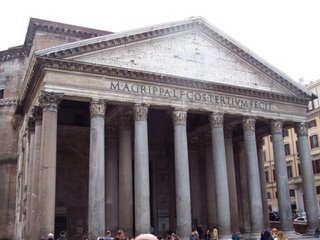 The only light to enter the building comes in through the 10m wide oculus in the centre of the dome. The original portico ceiling was lined with bronze, which was stripped by Pope Urban VIII to make bombards for Castel Sant'Angelo. The height to the oculus and the diameter of the interior circle are the same (43 metres), so the whole interior would fit exactly within a cube (alternatively, the interior could house a sphere 43
The only light to enter the building comes in through the 10m wide oculus in the centre of the dome. The original portico ceiling was lined with bronze, which was stripped by Pope Urban VIII to make bombards for Castel Sant'Angelo. The height to the oculus and the diameter of the interior circle are the same (43 metres), so the whole interior would fit exactly within a cube (alternatively, the interior could house a sphere 43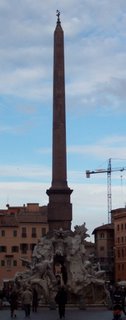 metres in diameter). The dome is the largest surviving from antiquity and was the largest dome in western Europe until Brunelleschi's dome of the Duomo of Florence was completed in 1436. The design of the Pantheon was the inspiration for the State Library of Victoria, in Melbourne.
metres in diameter). The dome is the largest surviving from antiquity and was the largest dome in western Europe until Brunelleschi's dome of the Duomo of Florence was completed in 1436. The design of the Pantheon was the inspiration for the State Library of Victoria, in Melbourne.Further on to Piazza Navone, which follows the plan of an acient Roman circus, in which mock sea battles and games were played. The fountain is another of Bernini's works: the Fountain of the Four Rivers. Sitting on the rocks, the giants symbolise the rivers of the four continents - the Danube, the Gangesm the Nile, and the Rio de la Plata, the four corners of the earth, with another obelisk on top.
Now around to the Roman Forum. This has been called the busiest deserted place in the world. In winter there aren't too many people - in summer it's very crowded and hot. The water in all the fountains is, however, very drinkable. The church behind this statue is Santa Luca e Martina, and was built in the 6th or 7th century.
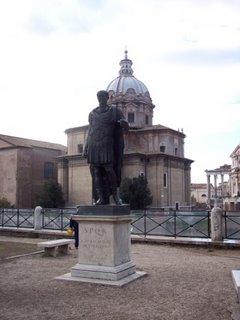 It was rebuilt with the dome in the 1600s, and stands where the Forum Romanun meets the Forum Augustus and the Forum Cesar. SPQR is everywhere in Rome, and represents the latin phrase Senatus Populusque Romani, or "The Senate and People of Rome" (alternatively, according to Obelisk, it stands for "Sono pazzi questi Romani", which translates into "These Romans are crazy !!) Don't get too excited when you see it on manhole covers etc though, it was put onto them by Mussolini an was used as propoganda for his regime.
It was rebuilt with the dome in the 1600s, and stands where the Forum Romanun meets the Forum Augustus and the Forum Cesar. SPQR is everywhere in Rome, and represents the latin phrase Senatus Populusque Romani, or "The Senate and People of Rome" (alternatively, according to Obelisk, it stands for "Sono pazzi questi Romani", which translates into "These Romans are crazy !!) Don't get too excited when you see it on manhole covers etc though, it was put onto them by Mussolini an was used as propoganda for his regime.On the left is the Forum Romanum - the Roman Forum. It takes a little while to get oriented and realise just how amazing it is to be able to actually stand here and look over this archaelogical site.
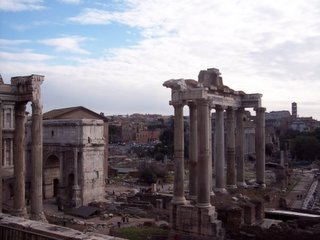 On the far left you can see the arch of Septimus Severus. This is a triumphal arch, erected in 203 AD to celebrate the victories of the Emporer Septimus Severus and his sons Caracella and Geta in te wars against the Parthians and the Osroeni in 195 and 197 AD. It spans the Via Sacra on the route of triumphal processions just before the ascent of the Capitoline Hill. To get an idea of the depth of excavations, the road was just below the top of the arch. The colums on the right were the Temple of Saturn. In the other photo below, more of the Forum is visible.
On the far left you can see the arch of Septimus Severus. This is a triumphal arch, erected in 203 AD to celebrate the victories of the Emporer Septimus Severus and his sons Caracella and Geta in te wars against the Parthians and the Osroeni in 195 and 197 AD. It spans the Via Sacra on the route of triumphal processions just before the ascent of the Capitoline Hill. To get an idea of the depth of excavations, the road was just below the top of the arch. The colums on the right were the Temple of Saturn. In the other photo below, more of the Forum is visible.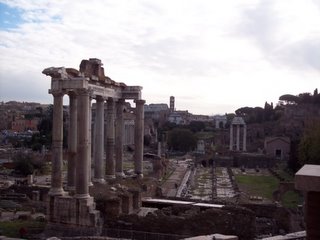 The three columns are the Temple of Castor and Pollux, and just behind this to the left is the remains of the House of the Vestal Virgins. Lots of other things to be seen here, but too many for a blog! In the background, of course, is the Colosseum..
The three columns are the Temple of Castor and Pollux, and just behind this to the left is the remains of the House of the Vestal Virgins. Lots of other things to be seen here, but too many for a blog! In the background, of course, is the Colosseum..Last thing along the Via Sacra before the Colosseum is
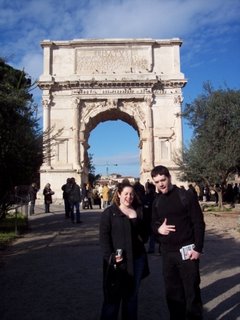 the Arch of Titus, built by the Senate after the Emporer's death to commemorate his conquest of Jerusalem in 70AD. Don't be too tempted to step over the chains and have your photo taken under the arch though... the last person to march under it was Hitler, and it's closed off to some extent as a mark of respect to Jews worldwide...
the Arch of Titus, built by the Senate after the Emporer's death to commemorate his conquest of Jerusalem in 70AD. Don't be too tempted to step over the chains and have your photo taken under the arch though... the last person to march under it was Hitler, and it's closed off to some extent as a mark of respect to Jews worldwide... Outside the Colosseum.. obviosuly waiting for next chariot race!! Dontcha love the one with the fag in his mouth!
Outside the Colosseum.. obviosuly waiting for next chariot race!! Dontcha love the one with the fag in his mouth!Lastly the Colosseum. The Colosseum was originally known as the Flavian Amphitheatre, and was capable in its day of seating 50000 spectators. Construction was started by Emporer Vespasian and completed by his sons Titus and Domitian between AD 72 and AD 81. It was built at the site of Nero's palace, the Domus Aurea, and derives the name Colosseum from a colossus - a 40m statue of Nero which once stood nearby. In the 100 days of celebration to inaugurate the opening of the amphitheatre, some 9,000 wild animals were killed. The arena floor was covered with sand, presumably to allow the blood to drain away. The Colosseum hosted large-scale spectacular games that included fights between animals, the killing of prisoners by animals and other executions, naval battles (via flooding the arena) up until AD 81, and combats between gladiators . It has been estimated that several hundreds of thousands died in the Colosseum games.
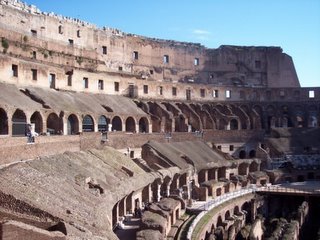
Seating was divided into different sections. The podium, the first level of seating, was for the Roman senators; the emperor's private, cushioned, marble box was also located on this level. Above the podium was the maenianum primum, for the other Roman aristocrats who were not in the senate. The third level, the maenianum secundum, was divided into three sections. The lower part was for wealthy citizens, while the upper part was for poor citizens. A third, wooden section was a wooden structure at the very top of the building, added by Domitian. It was standing room only, and was for lower-class women.
After the Colosseum's first two years in operation, Vespasian's younger son (the newly-designated Emperor Domitian) ordered the construction of the hypogeum (literally meaning "underground"), a two-level subterranean network of tunnels and cages where gladiators and animals were held before contests began. Numerous trap doors in the floor provided instant access to the arena for caged animals and scenery pieces concealed underneath; larger hinged platforms provided access for elephants and the like.
Today the arena floor no longer exists, though the hypogeum walls and corridors are clearly visible in the ruins of the structure. The entire base of the Colosseum covers an area equivalent to 6 acres. There are also tunnels, still in existence, configured to flood and evacuate water from the Colosseum floor, so that naval battles could be staged prior to the hypogeum's construction.
Monday, November 21, 2005
Pisa
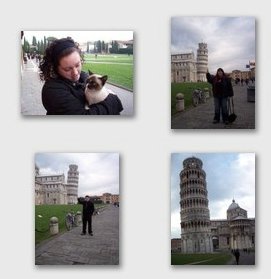
OK.. trying not to be too picky, but Pisa is a pretty grotty city. We took a train here from Firenze, and walked up to the Campo dei Miracoli or Field of Miracles from the station. This is beautiful and green, and the Leaning Tower is as spectacularly .. well.. leaning... as you would expect. It looks weird.
The Duomo and the Baptistry are gorgeous. Started in 1064, the outside of the Duomo (the Cathedral) has a facade of grey marble and white stone, set with discs of coloured marble. The pointed arches point to Muslim influences. There are massive bronze doors, not unlike the ones in Florence.
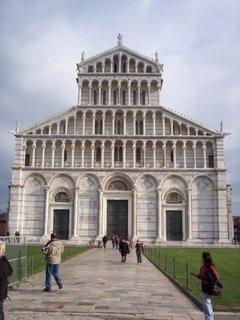
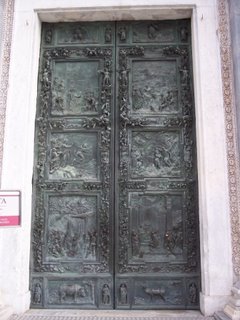
Next to these is the Baptistry. This was built in the 12th century and is dedicated to John the Baptist. It's a few centimetres higher than the Leaning Tower, which is quite surprising.
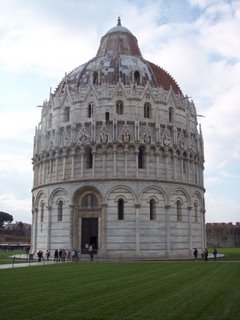
Firenze

And then another day another beautiful Italian city!
A few images of the magnificent Firenze - the second one from the Campanile (Bell Tower) of the Duomo (first pics) - 414 steps up.... arrrggghhhh keep thinking stair master!
The Basilica di Santa Maria del Fiore is the cathedral church, or Duomo, of the Catholic Archdiocese of Florence, noted for its distinctive dome. Its name (which translates as "Saint Mary of the Flower") refers to the lily, symbol of Florence. The cathedral complex includes the church proper, the baptistery and the campanile (bell tower).
The walls are covered in alternate vertical and horizontal bands with marble from Carrara (white), Prato (green), Siena (red), Lavenza and a few other places. These marble bands had to repeat the decorations of the Baptistery and Giotto's belltower. There are two lateral doors and six lateral windows, notable for their delicate tracery and ornaments. Only the four windows, closest to the transept, admit light; The other two are merely ornamental. The clerestory windows are round, a common feature in Italian Gothic. The floor of the church was laid in marble in the 16th century.During its long history, this cathedral has been the seat of the Council of Florence (1439) and witnessed the murder of Giuliano de' Medici on 26 April 1478 (with Lorenzo the Magnifico barely escaping death).
The duomo originally had a wooden dome, built by Arnolfo di Cambio. In 1418 a competition was held to design a new dome (or cupola) for the cathedral. The two competitors were Lorenzo Ghiberti (famous for his work on the "Gates of Paradise" doors at the Baptistery) and Filippo Brunelleschi. Brunelleschi constructed a wooden model with the help of Donatello and Nanni di Banco. Brunelleschi won by a nose. Ghiberti, appointed coadjutator, mocked these plans and called them unfeasable. Brunelleschi then pretended a sickness and gave the project to Ghiberti. But Ghiberti soon had to recognize that the whole project was beyond him. In 1423 Brunelleschi was back in charge and took over sole responsibility.
The distinctive octagonal design of the dome, resting on a drum and not on the roof itself, allowed for the entire dome to be built without the need for scaffolding. Work had started on the dome in 1420 and was completed in 1436; the cathedral was consecrated by Pope Eugenius IV on 1436-03-25 (the first day of the year, according to the Florentine calendar). It was the first 'octagonal' dome in history (The Roman Pantheon, a circular dome, was built in 118-128 C.E. without support structures) to be built without a wooden supporting frame, and was the largest dome built at the time (it is still the largest masonry dome in the world).

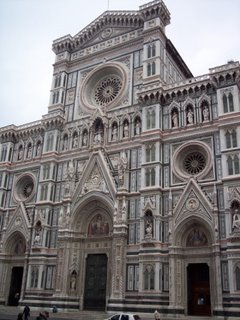
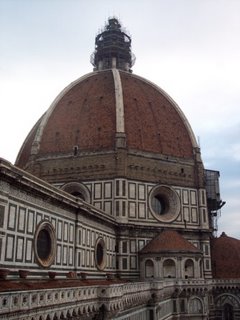
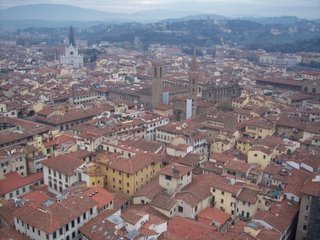
This was taken from the top of the Campanile. A Campanile is a free standing bell tower, and this one, designed and partially built by Giotto, is almost 85m high.
Of course Firenze is home to probably the most famous sculpture in the world, Michaelangelo's David. This statue is said to be a masterpiece of Renaissance sculpture and one of Michelangelo's two greatest works of sculpture, along with the Pietà. It is carved from a single piece of flawed marble, and is 434cm tall. David portrays the Biblical David at the moment that he decides to engage Goliath. This 5.17 m marble statue was commissioned as a symbol of the Florentine Republic.
Michelangelo's David is based on the artistic discipline of disegno, which is built on knowledge of the male human form. Under this discipline, sculpture is considered to be the finest form of art because it mimics divine creation. Because Michelangelo adhered to the concepts of disegno, he worked under the premise that the image of David was already in the block of stone he was working on — in much the same way as the human soul is thought to be found within the physical body. It is also an example of the contrapposto style of posing the human figure.
The proportions are not quite true to the human form; the head and upper body are somewhat larger than the proportions of the lower body. While some have suggested that this is of the mannerist style, the most commonly accepted explanation is that the statue was originally intended to be placed on a church façade or high pedestal, and that the proportions would appear correct when the statue was viewed from some distance below.
There is controversy, however, over the statue's supposed Biblical reference, since the statue portrays an uncircumcised male, whereas the historical King David was undoubtedly circumcised. Because of this fact, some art historians believe that "David" was actually the name of the model who posed for the statue, rather than King David himself, and that Michelangelo claimed the Biblical reference to make it acceptable to the Christian world. Again, this theory is merely speculation.
It has also been theorized that this was a conscientious decision, a consequence of Michelangelo's endeavor to emulate the ancient Greek aesthetic ideals, which regarded the circumcised penis as mutilated and inferior.
The statue was originally placed in the Piazza della Signoria, just in front of the Palazzo della Signoria. To protect it from damage, in 1873 it was moved to the Accademia Gallery. This is a photo of the copy - you are not allowed to photograph the original in the Galleria dell'Accademia.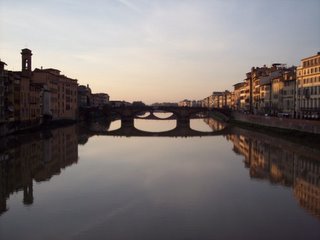 Finally, sunset over the Arno, taken from the Ponte Vecchio, which is Europe's largest segmented arch bridge and has many shops built into it.
Finally, sunset over the Arno, taken from the Ponte Vecchio, which is Europe's largest segmented arch bridge and has many shops built into it.It is said that the economic concept of bankruptcy originated here: when a merchant could not pay his debts, the table on which he sold his wares (the "banco") was physically broken ("rotto") by soldiers, and this practice was called "bancorotto" (broken table; possibly it can come from "banca rotta" which means "broken bank"). Not having a table anymore, the merchant was not able to sell anything.